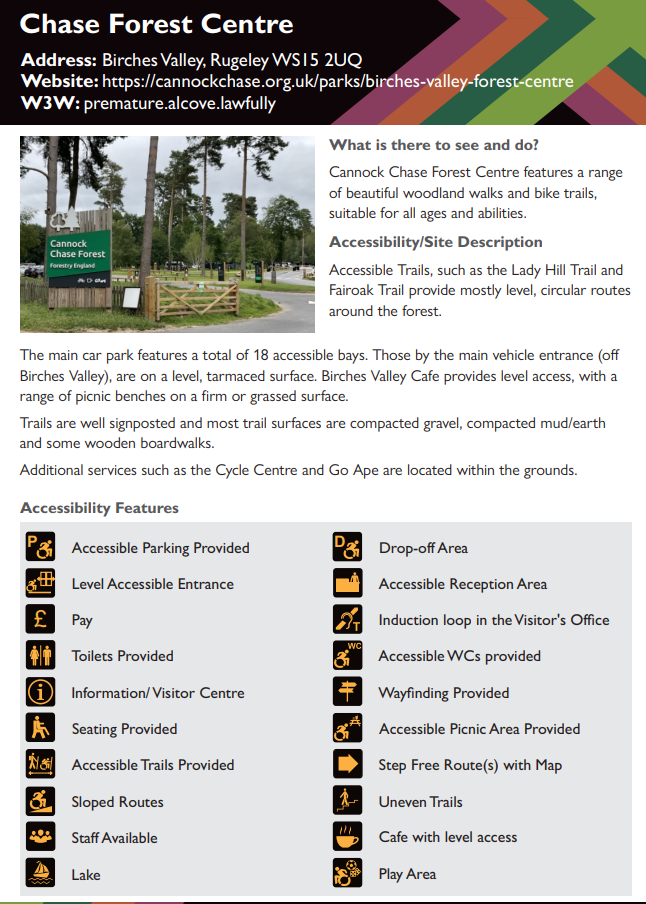
Whether you are a site owner providing an attraction to the public or are the custodian of a heritage site/museum, Accessibility and Sensory Guides are fast-becoming a standard of the overall visitor experience in public recreation, entertainment, and educational settings.
Working very much in the same way as a traditional leaflet or brochure, Access and Sensory Guides provide details of what there is to see and do at a particular space, while also offering information to visitors about inclusion and access. Typically, this would include provisions and modifications available that allow disabled people to participate, such as;
As a team of disabled people ourselves, we understand what it’s like to want to go somewhere, arrive on site, and realize that due to a lack of accessibility issues we are unable to participate, effectively wasting time, money, and in some extreme cases risk damage to our health and mental wellbeing.
Whether your site or facility could be considered truly inclusive or not, providing an Access Guide allows site owners to be transparent with their audience about the realities of their on-site accessibility provision, respecting the time of both existing visitors and new potential visitors.
Moreover, it reassures disabled people that they are being thought of, catered to, and that their inclusion and satisfaction is a priority for site owners. By allowing each individual to best identify what elements of a site are inclusive to their needs, you are ensuring each visitor can find something that specifically attracts them.
Typical accessibility guides will often focus on providing details about physical access. However, disability (as well as most best practice accessibility standards) goes beyond that and also includes people with cognitive, sensory impairments and neurodivergence. To accommodate people with these type of disability, we often recommend that sites commission a Sensory Guides – which details everything that a visitor can expect to experience on site in terms of sensory input (sight, hearing, smell, and, where relevant, touch and taste).
Sensory guides provide information about expected occurrences that might be troubling or stressful to people with such impairments, such as whether they can expect higher than average noise levels due to a site’s popularity at a certain time of the year, strong smells from food offered at on-site cafes, bars, and restaurants, and the kind of touch-based experiences on site, such as at parks, petting zoos, theme parks, and heritage sites.
In addition to providing physical copies at reception desks and at information booths, we strongly recommend providing digital copies of your Access guide variants ahead of time. This is because the idea that the visitor journey begins when a person first steps through the entrance is a misconception. In reality, the journey begins when a potential visitor to your site first has the thought of going there and is looking into opening times, services provided on-site, and how they would get there.
From both personal and professional experience, we can tell you that the majority of disabled people make it a habit to meticulously plan their day and allow for additional time. This is due to frequently experiencing frustration at the inaccessibility of wider society.
For this reason, detailed pre-visit information is an absolutely necessary reference for most disabled people when travelling and we would strongly encourage site owners publish their Access Guide on their website, making frequent reference to its availability on social media, which is often where people find out about new places to visit.
Finally, site owners must ensure that the delivery of the Access Guide itself is accessible and inclusive by ensuring the capacity to provide it in alternative formats when enquired by a disabled person. Braille and large print, for instance, are particularly important for those with visual impairments. For people with hearing impairments, site owners must consider providing an audio-described translation, and ensure that the Guides can be read online via a person’s screen reader.

When designing access guides for clients, our Accessible Media team consider additional elements which assist in their accessibility, such as the use of pictorial information, colour contrast, and Sans Serif fonts – which all have strong implications on the overall appeal, quality, and accessibility of documents. If you are interested in learning how we produce Access and Sensory Guides or would like to commission us for an accessibility audit, don’t hesitate to get in contact with our team today!